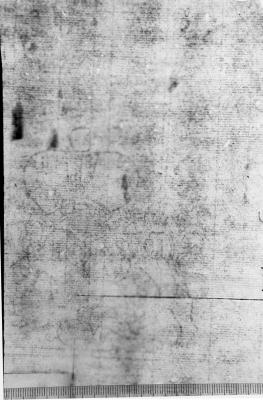
A native of Friuli, Pordenone worked throughout northern Italy, notably in Cremona, Piacenza, and, from 1528, Venice, where he soon became Titian’s chief rival. He was deeply influenced by the painting of Raphael and Michelangelo, which he saw on a visit to Rome sometime before 1520. Subsequently, he developed an intensely dramatic style characterized by impassioned movement and gesture as well as strong light effects that anticipate the art of Tintoretto.
This drawing relates to Pordenone’s work in Cremona, where in the early 1520s a succession of the most prominent artists of the northern Italian school, also including Boccaccio Boccaccino and Girolamo Romanino (see 1973.38), created a large-scale decorative fresco cycle with scenes from the life and Passion of Christ in the nave of the cathedral. Some of the last scenes fell to Pordenone, who was also responsible for much of the inner facade, notably the enormous Crucifixion of 1520–21, which is placed above the cathedral’s main entrance door and spans almost the entire width of the building.
Pordenone’s fresco of the Crucifixion, for which the Morgan drawing is a preparatory study, is easily the largest painting of its time in northern Italy and arguably the work which cemented the artist’s reputation as one of the great innovators of his generation.1 Unusually, it shows the crucified Christ off-center at right and turned at an oblique angle. The central position above the door is instead taken up by a soldier ostentatiously dressed in armor and resting on a heavy upright sword, directing the viewer’s attention toward the cross with a sweeping gesture. He is sometimes identified as the centurion who upon Christ’s death confessed before the crowd, “Truly, this was the Son of God” (Mark 15:39).2 Despite being seen from the back, the second most prominent figure is the soldier on horseback at right, whose nervously prancing horse causes a young boy to flee the scene. The Virgin lies in an ungainly heap in the left foreground, her head lining up in a diagonal trajectory with those of St. John the Evangelist, who has come to her aid, and of Christ. Powerfully conveying the dismay at and utter chaos of the portentous event, Pordenone’s scene seems to owe more to the expressionistic force of Matthias Grünewald than to the calm harmonies of the High Renaissance as represented by his contemporary Raphael.
The fresco of the Crucifixion must have presented a particular challenge to the artist, and several drawings related to this commission attest to the care with which he mapped out the large scene. All were executed in red chalk on cream paper, an unusual technique that Pordenone used only in his early drawings; he generally opted for pen and ink on Venetian blue paper later in his career (see I, 70).
The most complex and visionary of Pordenone’s early drawings, the Morgan study contains all the figurative elements that would constitute the fresco: Christ on the cross, small and vulnerable, raised high above the scene; the soldier on horseback at right; the centurion gesturing toward the figure of Christ; and the Virgin in a whorl of attendant figures. The horseman bearing the banner of Rome and figural groups for the background are adumbrated with a lighter touch. Whereas for the left two thirds of the composition the red chalk was applied with varying degrees of intensity and lightly smudged for chiaroscuro effect, the soldier on horseback at right is less finished and was drawn with a few brisk chalk lines. In fact, he originated from a different moment in the planning and was added on a separate piece of paper that occupies the lower right quadrant of the sheet. Several figure studies by Pordenone—one each for this figure of the soldier on horseback in the Louvre, the Albertina, and the Galleria Estense, Modena, and one for the fleeing young man in the foreground of the fresco in the Boijmans van Beuningen Museum, Rotterdam—are also known.3 A further red chalk drawing in the Biblioteca Ambrosiana, Milan, showing Christ being nailed to the cross is also considered a study for the Cremona cycle.4
—REP
Footnotes:
- Puerari 1971, fig. 230. See Cremona 1997– 98, 169.
- Tomei 2001, 170.
- Musée du Louvre, Paris, inv. 5671; see Cremona 1997–98, no. 16. Albertina, Vienna, inv. 2408; see Cremona 1997–98, no. 17. Galleria Estense, Modena, inv. 88; see Cohen 1996, no. 33. Boijmans van Beuningen Museum, Rotterdam, inv. I, 37. see Cremona 1997–98, no. 18.
- Biblioteca Ambrosiana, Milan, Cod. F. 269 inf. 39. See Furlan 1988, no. D4.
Watermark: Coat of arms, possibly arms of Amsterdam, lined drawing.
Campi, Bernardino, 1521-1591, Formerly attributed to.
Lanier, Nicholas, 1588-1666, former owner.
Richardson, Jonathan, 1665-1745, former owner.
Robinson, J. C. (John Charles), Sir, 1824-1913
Morgan, J. Pierpont (John Pierpont), 1837-1913
Morgan, J. P. (John Pierpont), 1867-1943, former owner.
Rhoda Eitel-Porter and and John Marciari, Italian Renaissance Drawings at the Morgan Library & Museum, New York, 2019, no. 76.
Selected references: Berenson 1903, no. 2490; Fairfax Murray 1905-12, 4: no. 69; Fiocco 1943, 84, 88, 111, 126; Tietze and Tietze-Conrat 1944, 233, 239; New York 1965-66, no. 52; Cohen 1972, 128; Cohen 1975a, 31; Rearick 1976, 44-45; Cohen 1980, 104; Furlan 1988, no. D5; Rearick 2001, 76-77, 79; Tomei 2001, 170-73; Villata 2016, 72-73.
Collection J. Pierpont Morgan : Drawings by the Old Masters Formed by C. Fairfax Murray. London : Privately printed, 1905-1912, IV, 69 repr.

